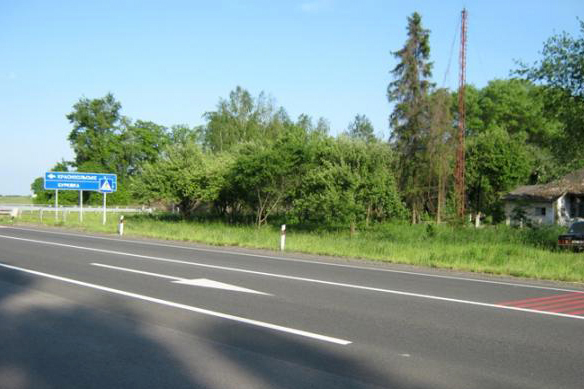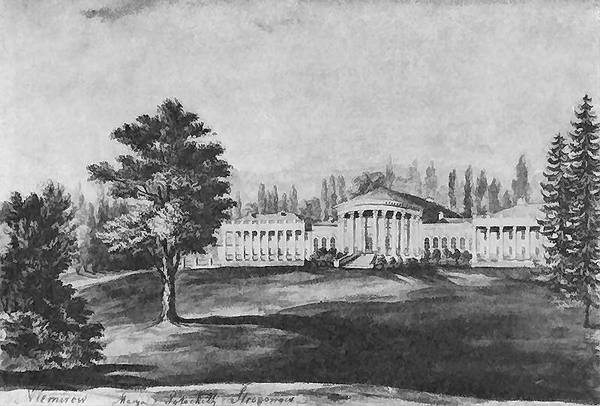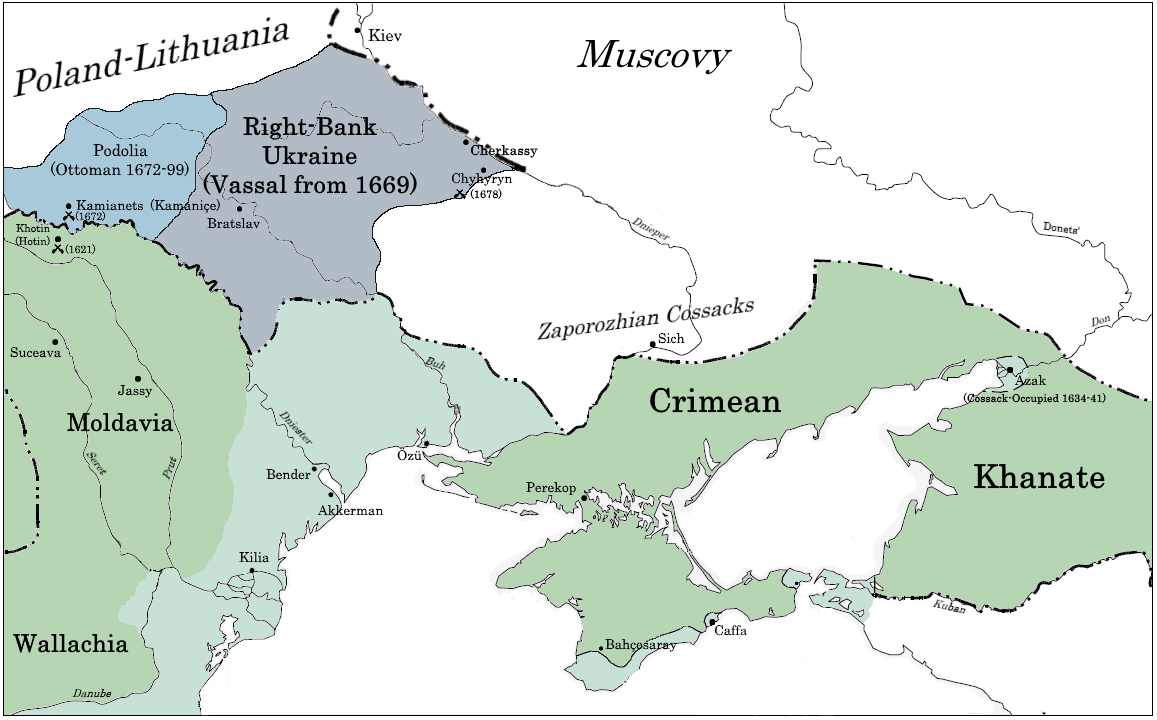|
Semyon Paliy
Semyon Paliy or Semen Palii (, , ) (early 1640s – 24 January / 13 May 1710) was a Zaporozhian Cossack polkovnyk (colonel). Paliy was compared to Ivan Sirko due to his exploits against Crimean Tatars and Ottoman Turks. Origin Semyon Paliy's middle name is Filipovich, and real last name is Gurko. Paliy was born in 1640. He's native to the town of Borzna, Chernihiv region. Paliy settled in the Zaporizhian Sich during 1670s, gaining fame as a brave fighter and Zaporozhian Cossack. Career In 1683, Paliy led a force consisting of 5,000 Zaporozhian Cossacks during Battle of Vienna. In 1685, Paliy moved to Right-bank Ukraine and joined the service of Polish–Lithuanian Commonwealth, under King John III Sobieski. During his years in Polish service, Paliy proved himself as an able Cossack commander in wars against Crimean Tatars and Ottoman Turks. Among other military deeds his men achieved, Paliy's Cossacks successfully raided Ottoman fortresses, among which were Ochakov, Ak ... [...More Info...] [...Related Items...] OR: [Wikipedia] [Google] [Baidu] |
Borzna
Borzna (, ), also referred to as Borsna, is a city in Nizhyn Raion, Chernihiv Oblast, northern Ukraine. It hosts the administration of Borzna urban hromada, one of the hromadas of Ukraine. Population: Geography Borzna is located on the Desna (river), Desna, next to an international highway connecting Kyiv and Moscow (International E-road network, E101). Chernihiv is about away. Borzna has no Rail transport, railway (the nearest railway stations being Doch () with north–south routes and Plysky () with west–east routes. The city derives its name from the river it lies on, a tributary of the Desna River, Desna. Climate Borzna has a continental climate, humid continental climate (Köppen climate classification, Koppen ''Dfb''). The warmest months are June, July, and August, with mean temperatures of . The coldest are December, January, and February, with mean temperatures of . The highest ever temperature recorded in the town was in July 2010. The coldest temperature ev ... [...More Info...] [...Related Items...] OR: [Wikipedia] [Google] [Baidu] |
Polkovnyk
(; ) is a military rank used mostly in Slavic-speaking countries which corresponds to a colonel in English-speaking states, ''coronel'' in Spanish and Portuguese-speaking states and '' oberst'' in several German-speaking and Scandinavian countries. It was originally a rank in the Polish–Lithuanian Commonwealth and the Russian Empire. However, in Cossack Hetmanate and Sloboda Ukraine, ''polkovnyk'' was an administrative rank similar to a governor. Usually this word is translated as colonel, however the transliteration is also in common usage, for the sake of the historical and social context. began as a commander of a distinct group of troops (''polk''), arranged for battle. The exact name of this rank maintains a variety of spellings in different languages, but all descend from the Old Slavonic word ''polk'' (literally: regiment sized unit), and include the following in alphabetical order: # Belarus — # Bosnia and Herzegovina, Croatia, Montenegro and Serbia — () # Bu ... [...More Info...] [...Related Items...] OR: [Wikipedia] [Google] [Baidu] |
Nemyriv
Nemyriv ( ; ) is a historic city in Vinnytsia Oblast (province) in Ukraine, located in the historical region of Podolia. It was the administrative center of former Nemyriv Raion (district). Population: Nemyriv is one of the oldest cities in Vinnytsia Oblast, Ukraine. It was founded by Prince Nemyr in 1390. It is a minor industrial center. The distiller company that produces Ukrainian Nemiroff (Russian spelling) vodka is located in Nemyriv. The town's tourist attractions include a late 19th-century palace (which belonged to the House of Potocki) and a park complex. History Nemyriv was built on the site of ancient Scythian settlement Myriv, destroyed during the Mongol invasion of Rus'. The settlement was re-established at the end of the 14th century and the first written mention of the city under its modern name in 1506. Nemyriv ultimately derives from the Slavic given name Niemir. It was a private town of Poland, owned by the families of Zbaraski and Potocki. Polish K ... [...More Info...] [...Related Items...] OR: [Wikipedia] [Google] [Baidu] |
Hetman Of Zaporizhian Cossacks
A Hetman of Zaporizhian Cossacks is a historical term that has multiple meanings. Officially the post was known as Hetman of the Zaporizhian Host ().Mytsyk, Yu. Hetman (ГЕТЬМАН)'. Encyclopedia of History of Ukraine. Hetman of Zaporizhian Cossacks as a title was not officially recognized internationally until the creation of the Cossack Hetmanate. With the creation of Registered Cossacks units their leaders were officially referred to as Senior of His Royal Grace Zaporozhian Host (, ''Starshyi Yoho Korolivskoi Mylosti Viiska Zaporozkoho''). Before 1648 and the establishment of the Cossack Hetmanate there were numerous regional hetmans across the Dnieper-banks, who usually were starostas or voivodes. The first widely recognized hetman of Zaporizhia was Dmytro Vyshnevetsky, after that several Polish starostas were added to the Hetman registry such as Lanckoroński and Daszkiewicz who also led their own Cossack formations. According to Mykhailo Hrushevsky they were not really ... [...More Info...] [...Related Items...] OR: [Wikipedia] [Google] [Baidu] |
Left-bank Ukraine
The Left-bank Ukraine is a historic name of the part of Ukraine on the left (east) bank of the Dnieper River, comprising the modern-day oblasts of Chernihiv, Poltava and Sumy as well as the eastern parts of Kyiv and Cherkasy. Left-bank Ukraine is bordered by the historical regions of Right-bank Ukraine to the southwest, Zaporizhzhia to the southeast, Sloboda Ukraine to the east, and Polesia and White Ruthenia to the north. History Since the Middle Ages, the region formed part of the Khazar Khanate, Kievan Rus', Mongol Empire, Golden Horde, Grand Duchy of Lithuania and the Kingdom of Poland. The term appeared in 1663 with the election of Ivan Bryukhovetsky as the hetman of Ukraine in opposition to Pavlo Teteria. Bryukhovetsky was the first known "left-bank Ukraine" hetman over the area, that was under the Russian influence. Up until the mid-17th century, the area had belonged to the Polish–Lithuanian Commonwealth. The Treaty of Pereyaslav of 1654 saw the region tent ... [...More Info...] [...Related Items...] OR: [Wikipedia] [Google] [Baidu] |
Ataman
Ataman (variants: ''otaman'', ''wataman'', ''vataman''; ; ) was a title of Cossack and haidamak leaders of various kinds. In the Russian Empire, the term was the official title of the supreme military commanders of the Cossack armies. The Ukrainian version of the same word is '' hetman''. ''Otaman'' in Ukrainian Cossack forces was a position of a lower rank. Etymology The etymologies of the words ''ataman'' and '' hetman'' are disputed. There may be several independent Germanic and Turkic origins for seemingly cognate forms of the words, all referring to the same concept. The ''hetman'' form cognates with German '' Hauptmann'' ('captain', literally 'head-man') by the way of Czech or Polish, like several other titles. The Russian term ''ataman'' is probably connected to Old East Slavic ''vatamanŭ,'' and cognates with Turkic ''odoman'' ( Ottoman Turks). The term ''ataman'' may have also had a lingual interaction with Polish ''hetman'' and German ''hauptmann''. Suggestions hav ... [...More Info...] [...Related Items...] OR: [Wikipedia] [Google] [Baidu] |
Moldavia
Moldavia (, or ; in Romanian Cyrillic alphabet, Romanian Cyrillic: or ) is a historical region and former principality in Eastern Europe, corresponding to the territory between the Eastern Carpathians and the Dniester River. An initially independent and later autonomous state, it existed from the 14th century to 1859, when it united with Wallachia () as the basis of the modern Romanian state; at various times, Moldavia included the regions of Bessarabia (with the Budjak), all of Bukovina and Hertsa region , Hertsa. The region of Pokuttya was also part of it for a period of time. The Moldavia (region of Romania) , western half of Moldavia is now part of Romania, the eastern side belongs to the Moldova , Republic of Moldova, and the Chernivtsi Oblast , northern and Budjak , southeastern parts are territories of Ukraine. Name and etymology The original and short-lived reference to the region was ''Bogdania'', after Bogdan I, the founding figure of the principality. The name ... [...More Info...] [...Related Items...] OR: [Wikipedia] [Google] [Baidu] |
Ochakov
Ochakiv (, ), also known as Ochakov (; ; or, archaically, ) and Alektor (), is a small city in Mykolaiv Raion, Mykolaiv Oblast (region) of southern Ukraine. It hosts the administration of Ochakiv urban hromada, one of the hromadas of Ukraine. Its population is Of the 14,000 people who lived in Ochakiv before the war, only half remained. For many years the city fortress served as a capital of the Ottoman province (eyalet) of Özu (Silistria). Geography The city is located at the mouth of Dnieper, on the banks of the Dnieper-Bug Estuary. Between the Cape of Ochakiv (northern bank) and the Kinburn Spit (southern bank) there are only . The Ochakiv and Kinburn fortresses controlled the entrance to Dnieper and Bug. History Establishment and names The strip of land on which Ochakov is located was inhabited by Thracians and Scythians in ancient times. It was known as a part of Great Scythia. In the 7th and 6th centuries BC, Greek colonists had founded a commercial colony town, n ... [...More Info...] [...Related Items...] OR: [Wikipedia] [Google] [Baidu] |
John III Sobieski
John III Sobieski ( (); (); () 17 August 1629 – 17 June 1696) was King of Poland and Grand Duke of Lithuania from 1674 until his death in 1696. Born into Polish nobility, Sobieski was educated at the Jagiellonian University and toured Europe in his youth. As a soldier and later commander, he fought in the Khmelnytsky Uprising, the Russo-Polish War (1654–1667), Russo-Polish War and during the Swedish invasion known as the Deluge (history), Deluge. Sobieski demonstrated his military prowess during the war against the Ottoman Empire and established himself as a leading figure in Polish–Lithuanian Commonwealth, Poland and Lithuania. In 1674, he was elected monarch of the Polish–Lithuanian Commonwealth following the sudden and unexpected death of Michael Korybut Wiśniowiecki, King Michael. Sobieski's 22-year reign marked a period of the Commonwealth's stabilization, much needed after the turmoil of previous conflicts. Popular among his subjects, he was an able military l ... [...More Info...] [...Related Items...] OR: [Wikipedia] [Google] [Baidu] |
Polish–Lithuanian Commonwealth
The Polish–Lithuanian Commonwealth, also referred to as Poland–Lithuania or the First Polish Republic (), was a federation, federative real union between the Crown of the Kingdom of Poland, Kingdom of Poland and the Grand Duchy of Lithuania, existing from 1569 to 1795. This state was among the largest, most populated countries of 16th- to 18th-century Europe. At its peak in the early 17th century, the Commonwealth spanned approximately and supported a multi-ethnic population of around 12 million as of 1618. The official languages of the Commonwealth were Polish language, Polish and Latin Language, Latin, with Catholic Church, Catholicism as the state religion. The Union of Lublin established the Commonwealth as a single entity on 1 July 1569. The two nations had previously been in a personal union since the Union of Krewo, Krewo Agreement of 1385 (Polish–Lithuanian union) and the subsequent marriage of Queen Jadwiga of Poland to Grand Duke Jogaila of Lithuania, who was cr ... [...More Info...] [...Related Items...] OR: [Wikipedia] [Google] [Baidu] |
Right-bank Ukraine
The Right-bank Ukraine is a historical and territorial name for a part of modern Ukraine on the right (west) bank of the Dnieper River, corresponding to the modern-day oblasts of Vinnytsia, Zhytomyr, Kirovohrad, as well as the western parts of Kyiv and Cherkasy. It was separated from the left bank during the Ruin. Right-bank Ukraine is bordered by the historical regions of Volhynia and Podolia to the west, Moldavia to the southwest, Yedisan and Zaporizhzhia to the south, left-bank Ukraine to the east, and Polesia to the north. Main cities of the region include Cherkasy, Kropyvnytskyi, Bila Tserkva, Zhytomyr and Oleksandriia. History Since the Middle Ages, the region formed part of the Khazar Khanate, Kievan Rus', Mongol Empire, Golden Horde, Grand Duchy of Lithuania and the Kingdom of Poland. Right-bank Ukraine was the target of slave raids by Tatars from the Black Sea steppes. The history of right- and left-bank Ukraine is closely associated with the Khmelnyt ... [...More Info...] [...Related Items...] OR: [Wikipedia] [Google] [Baidu] |
Zaporizhian Sich
The Zaporozhian Sich (, , ; also ) was a semi-autonomous polity and proto-state of Zaporozhian Cossacks that existed between the 16th to 18th centuries, for the latter part of that period as an autonomous stratocratic state within the Cossack Hetmanate. The lands of Zaporozhian Sich were centred around the Great Meadow region of Ukraine, spanning the lower Dnieper river. In different periods the area came under the sovereignty of the Polish–Lithuanian Commonwealth, the Ottoman Empire, the Tsardom of Russia, and the Russian Empire. The establishment of Zaporozhian Sich was an important factor in defense of Ukraine and Russia from Crimean-Nogai raids. In 1650, its total population consisted of 100,000. In 1657–1687, Zaporizhian Sich was practically independent, possessing its own administration and armed forces consisting of 12,000–20,000 Cossacks. It was reliant on population growth, mainly consisting of Ukrainian refugees from devastated lands. In 1775, shortly af ... [...More Info...] [...Related Items...] OR: [Wikipedia] [Google] [Baidu] |







